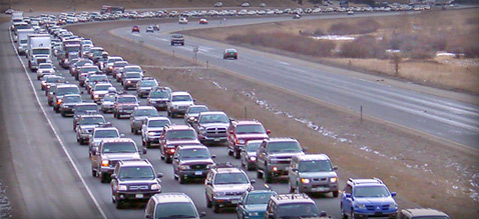Widgetized Section
Go to Admin » Appearance » Widgets » and move Gabfire Widget: Social into that MastheadOverlay zone
Colorado floats rule to reduce greenhouse gas emissions from transportation sector

Colorado transportation officials have unveiled a proposal that they say will help reduce air pollution from cars and trucks and bring state and local infrastructure projects in line with the state’s greenhouse gas emissions goals.
In a formal notice issued Monday, the state’s Transportation Commission announced that it plans to move forward with a proposed rule that would require certain transportation planning efforts to comply with greenhouse gas pollution standards. The commission will hold a series of public hearings on the proposal beginning next month, and could vote to adopt the rule as soon as November.
The proposed rule, drafted by staff at the Colorado Department of Transportation, is a key plank in efforts by Gov. Jared Polis’ administration to meet statewide greenhouse gas reduction targets that were enshrined into law in 2019.
“What we build matters. It matters for safety, for our economy, for resiliency and for our ability to reduce air pollution and improve the quality of places where Coloradans across the state live and thrive,” CDOT executive director Shoshana Lew said in a statement. “From smoke-filled air to a confluence of fire and 500-year flooding in Glenwood Canyon, we are reminded that we have no time to waste in fighting climate change in the transportation sector, and this policy will be an important step.”
In addition to governing CDOT’s own statewide plans, the new rule would apply to regional transportation blueprints developed by metropolitan planning organizations, federally-mandated bodies that bring together county and municipal governments to coordinate infrastructure planning in densely populated areas.
Colorado has five MPOs, which oversee regional planning for Denver, Colorado Springs, Fort Collins, Pueblo and Grand Junction. Federal law requires each of them to submit periodic reports, including a 20-year plan outlining their goals, strategies and funding priorities, which must be revised every five years.
Under the proposed rule, any such planning documents adopted after Oct. 1, 2022 would need to comply with a series of statewide targets for reducing transportation emissions, including by adopting pre-approved “mitigation measures” like providing additional transit services or improving bike and pedestrian infrastructure. If MPOs fail to comply, Colorado would withhold state funding from certain high-emitting projects, “requiring that dollars be focused on projects that help reduce transportation emissions,” the rule says.
In recent years, transportation-sector emissions — which mostly come from cars, trucks and other gasoline-powered vehicles — have overtaken electricity generation as Colorado’s largest source of greenhouse gases, according to state estimates. Limiting greenhouse gas emissions from transportation would also help improve air quality in Colorado, since cars and trucks also emit gases that contribute to high levels of ozone and other forms of air pollution.
“We’re always talking about Colorado’s smog issue, and this rulemaking is our chance to do something about it,” Carter Rubin, a transportation technical strategist with the Natural Resources Defense Council, said in a statement. “(CDOT) has a chance to help us say goodbye to the brown cloud by investing in safer streets and reliable public transportation in the communities that need them most.”
‘They’re going to have to be more aggressive'The newly proposed rule was the top transportation-sector policy identified by the Polis administration’s “roadmap” for reducing greenhouse gas emissions earlier this year. Its release, however, comes just weeks after another policy outlined in the roadmap, the Employee Traffic Reduction Program, was scrapped by state regulators amid pushback from business groups.
“(ETRP) was a tool that would’ve helped reduce some emissions,” Jacob Smith, executive director of Colorado Communities for Climate Action, said in an interview. “And they’ve basically taken it off the table, which just means now every other tool in the toolbox is going to have to do more work. They’re going to have to be more aggressive, and push harder with those other tools than they would have otherwise.”
In response to CDOT’s rulemaking notice, environmental advocates released a checklist grading the proposed rule according to a range of criteria. Advocates say they’re concerned about potential loopholes, and want to see more specific deadlines and enforcement mechanisms relating to the “mitigation measures” that MPOs would be required to adopt.
“The most important element of this new rulemaking will be whether or not it’s enforceable,” Smith said. “Does it actually require reductions, or is it more of, cross your fingers and hope that something happens?”
Environmental groups also say they want to see a greater focus on environmental justice in the final rule, including by developing a transportation-focused “climate equity framework” similar to the one drafted by climate staff at the Colorado Department of Public Health and Environment.
“We are concerned that unless the rulemaking is bolder, it will miss the mark on the transportation emission reductions the governor set in his climate roadmap,” Jenny Gaeng, a transportation advocate with Conservation Colorado, said in a statement. “Additionally, Black, Indigenous, Latinx, and other people of color are hurt worst by transportation pollution — and this rule needs to address that explicitly with a plan for how to do better.”
CDOT plans to hold at least eight public meetings on the proposed rule in September and October, beginning with a hearing in Durango on Sept. 14. Information about how to register to speak at the hearings is available on CDOT’s website, and Coloradans can also submit written comment on the rules online until Oct. 15.
Editor’s note: This article first appeared on Colorado Newsline, which is part of States Newsroom, a network of news bureaus supported by grants and a coalition of donors as a 501c(3) public charity. Colorado Newsline maintains editorial independence. Contact Editor Quentin Young for questions: info@coloradonewsline.com. Follow Colorado Newsline on Facebook and Twitter.


